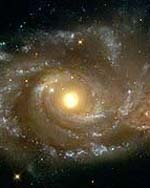
Image credit: Hubble
When black holes collide, look out! An enormous burst of gravitational radiation results as they violently merge into one massive black hole. The ?kick? that occurs during the collision could knock the black hole clear out of its galaxy.
A new study describes the consequences of such an intergalactic collision.
Astrophysicist David Merritt, professor at Rochester Institute of Technology, and co-authors Milos Milosavljevic (Caltech), Marc Favata (Cornell University), Scott Hughes (Massachusetts Institute of Technology) and Daniel Holz (University of Chicago) explore the consequences of kicks induced by gravitational waves in their article, ?Consequences of Gravitational Radiation Recoil,? recently submitted to the Astrophysical Journal and posted online at http://arXiv.org/abs/astro-ph/0402057.
Virtually all galaxies are believed to contain supermassive black holes at their centers. According to current theory, galaxies grow through mergers with other galaxies. When two galaxies merge, their central black holes form a binary system and revolve around each other, eventually coalescing into a single black hole. The coalescence is driven by the emission of gravitational radiation, as predicted by Einstein?s theory of relativity.
Merritt and his colleagues determined how fast a black hole has to move to completely escape a galaxy?s gravitational field. They found that larger and brighter galaxies have stronger gravitational fields and would require a bigger kick to eject a black hole than the smaller systems. Likewise, less forceful impacts could jar the black hole out of its home at the center of a galaxy, only to later rebound back into position.
The kicks also call into question theories that would grow supermassive black holes from hierarchical mergers of smaller black holes, starting in the early universe. ?The reason is that galaxies were smaller long ago, and the kicks would easily have removed the black holes from them,? Merritt says.
According to Merritt and his co-authors, it is more likely that supermassive black holes attained most of their mass through the accretion of gas and that mergers with other black holes only took place after the galaxies had reached roughly their current sizes.
?We know that supermassive black holes exist at the centers of giant galaxies like our own Milky Way,? says Merritt. ?But as far as we know, the smaller stellar systems do not have any black holes. Perhaps they used to, but they were kicked out.?
The kick?a consequence of Einstein?s relativity equations?occurs because gravitational waves emitted during the final plunge are anisotropic, producing recoil. The effect is maximized when one black hole is appreciably larger than the other one.
While astrophysicists have been aware of this phenomenon since the 1960s, until now no one has had the analytical tools necessary to accurately calculate the size of the effect. The first accurate calculation of the size of the kicks was reported in a companion paper by Favata, Hughes and Holz, which also appears online at http://arXiv.org.
Merritt notes that there is no clear observational evidence that the kicks have taken place. He contends that the best chance of finding direct evidence would be locating a black hole shortly after the kick occurs, perhaps in a galaxy that has recently undergone a merger with another galaxy.
?You would see an off-center black hole that hasn?t quite made its way back to the center yet,? he says. ?Even though the probability of observing this is low, now that astronomers know what to look for, I wouldn?t be surprised if someone finds one eventually.?
Original Source: RIT News Release
